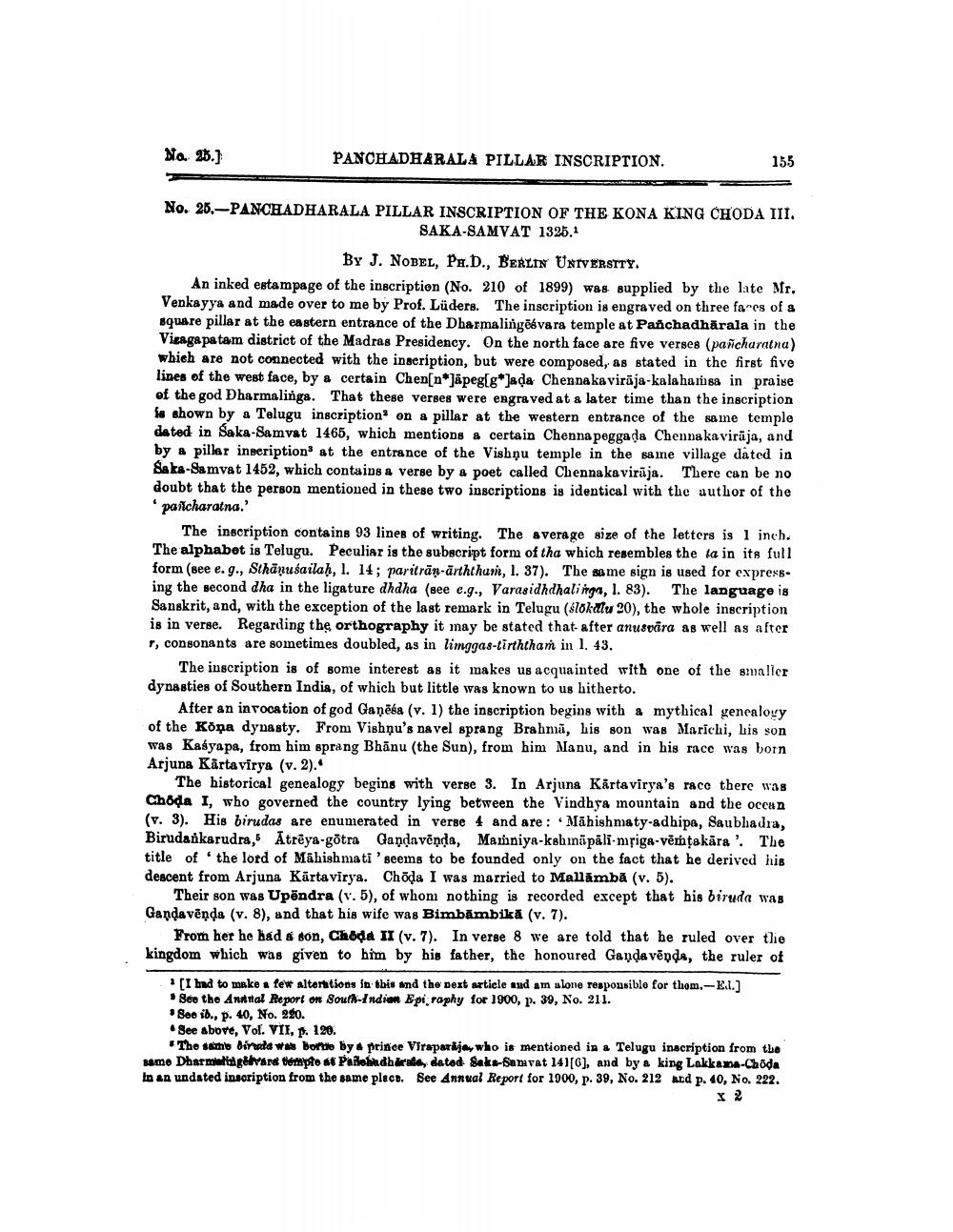________________
No 25.)
PANCHADHARALA PILLAR INSCRIPTION.
155
No. 25.- PANCHADHARALA PILLAR INSCRIPTION OF THE KONA KING CHODA III.
SAKA-SAMVAT 1325.1
By J. NOBEL, PH.D., BERLIN UNIVERSITY. An inked estampage of the inscription (No. 210 of 1899) was supplied by the late Mr. Venkayya and made over to me by Prof. Lüders. The inscription is engraved on three fares of a square pillar at the eastern entrance of the Dharmalingesvara temple at Panchadhārala in the Vizaga pa tam district of the Madras Presidency. On the north face are five verses (pancharatna) which are not connected with the inscription, but were composed, as stated in the first five lines of the west face, by a certain Chen[n]åpeg[gada Chenna kaviraja-kala harinsa in praise of the god Dharmalinga. That these verses were engraved at a later time than the inscription is shown by a Telugu inscription' on a pillar at the western entrance of the same temple dated in Saka-Samvat 1465, which mentions & certain Chenna peggada Chenna kaviraja, and by a pillar inseription at the entrance of the Vishņu temple in the same village dated in Sa ka-Samvat 1452, which contains a verse by & poet called Chennaka virāja. There can be no doubt that the person mentioned in these two inscriptions is identical with the author of the pancharatna.'
The inscription contains 93 lines of writing. The average size of the letters is 1 inch. The alphabet is Telugu. Peculiar is the subscript form of tha which resembles the ta in its full form (see e. g., Sthānuśailah, l. 14; paritrān-arththur, l. 37). The same sign is used for expressing the second dha in the ligature dhdha (see e.g., Varasidhdhalingh, I. 83). The language is Sanskrit, and, with the exception of the last remark in Telugu (slokalu 20), the whole inscription is in verse. Regarding the orthography it may be stated that after anusvira as well as after , consonants are sometimes doubled, as in limggas-tirththan in 1. 43.
The inscription is of some interest as it makes us acquainted with one of the smaller dynasties of Southern India, of which but little was known to us hitherto.
After an invocation of god Ganēća (v. 1) the inscription begins with a mythical genealogy of the Kona dynasty. From Vishnu's na vel sprang Brahmā, his son was Marichi, Lis son was Kasyapa, from him sprang Bhānu (the Sun), from him Manu, and in his race was born Arjuna Kärta virya (v. 2).
The historical genealogy begins with verse 3. In Arjuna Kärta virya's race there was Choda I, who governed the country lying between the Vindhya mountain and the occan (v. 3). His birudas are enumerated in verge 4 and are: Māhishmaty-adhipa, Saubhadra, Birudankarudra, Atrêya-gotra Gandavēnda, Manniya-kehinūpäli-mpiga-vērtakära!. The title of the lord of Mahishmati 'seems to be founded only on the fact that he derived his descent from Arjuna Kärta virya. Chôda I was married to Mallămbă (v. 5).
Their son was Upöndra (v. 5), of whom nothing is recorded except that his biruda was Gandavēnda (v. 8), and that his wife was Bimbămbika (v.7).
From her he had a son, Choda II (v.7). In verse 8 we are told that he ruled over tlie kingdom which was given to him by his father, the honoured Ganda vēnde, the ruler of
1 [I had to make a few altonations in this and the next article and am alone responsible for thom.-EL.] See the Anittal Report on South Indian Epi raphy for 1900, p. 39, No. 211. Soo ib., p. 40, No. 280. See above, Vol. VII, p. 120.
The same dinała w bottle by prince Viraparija, who is mentioned in a Telugu inscription from the Mamo Dharmalige vara teryto a Palohudhrade, dated Saku Sanavat 14)[0), and by a king Lakkaxa-Choda In an undated inscription from the same place. See Annual Report for 1000, p. 39, No. 212 aud p. 40, No. 222.




